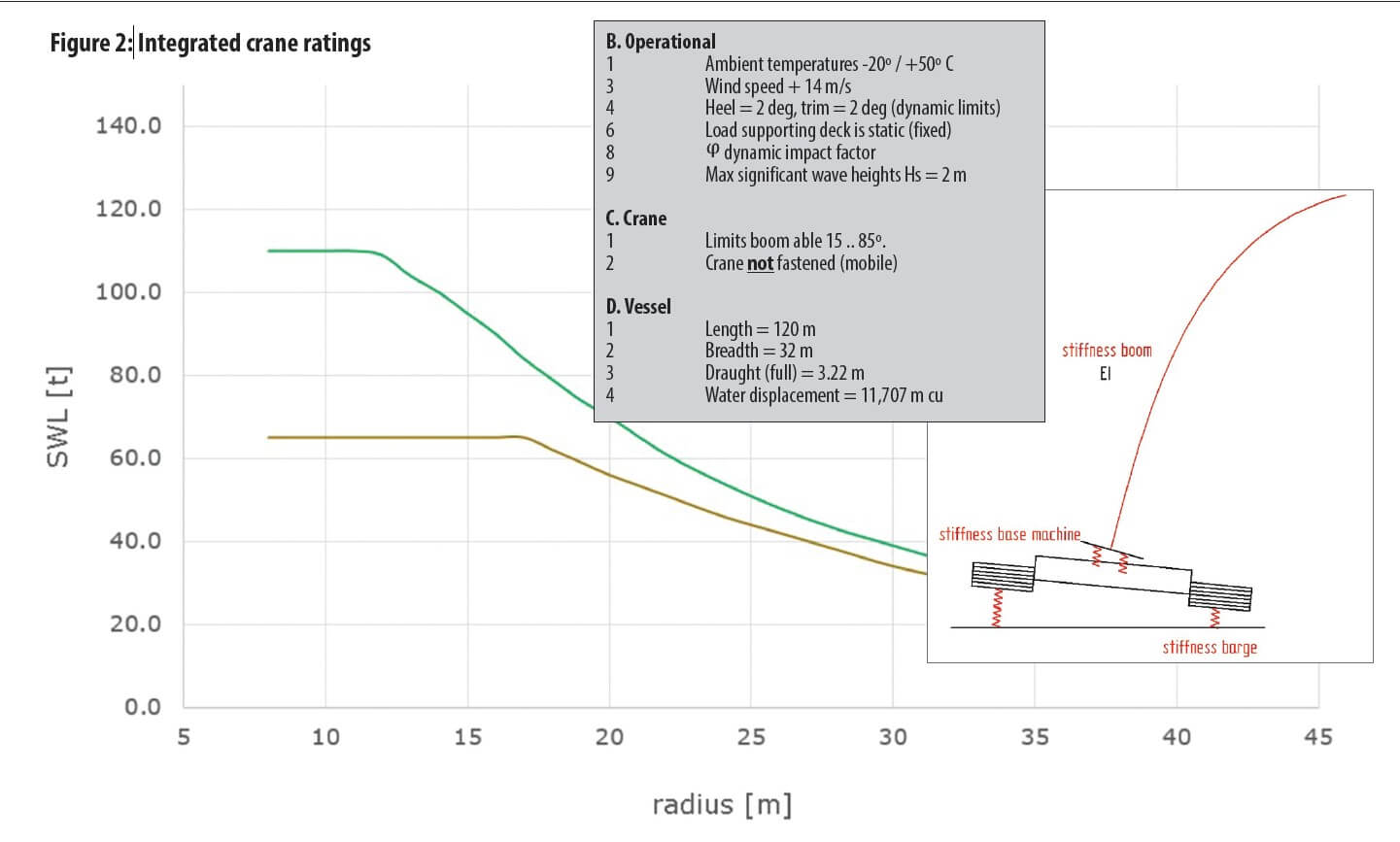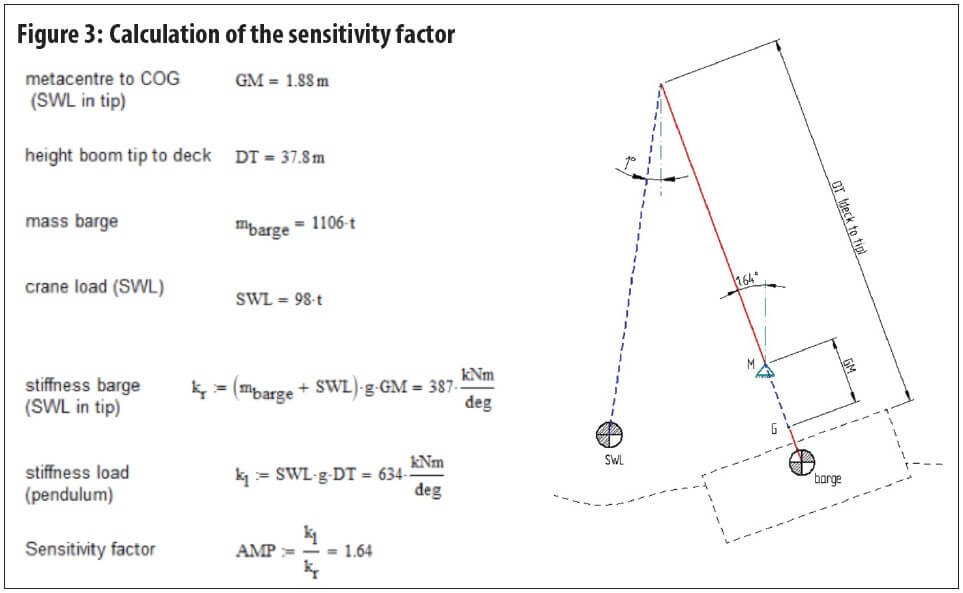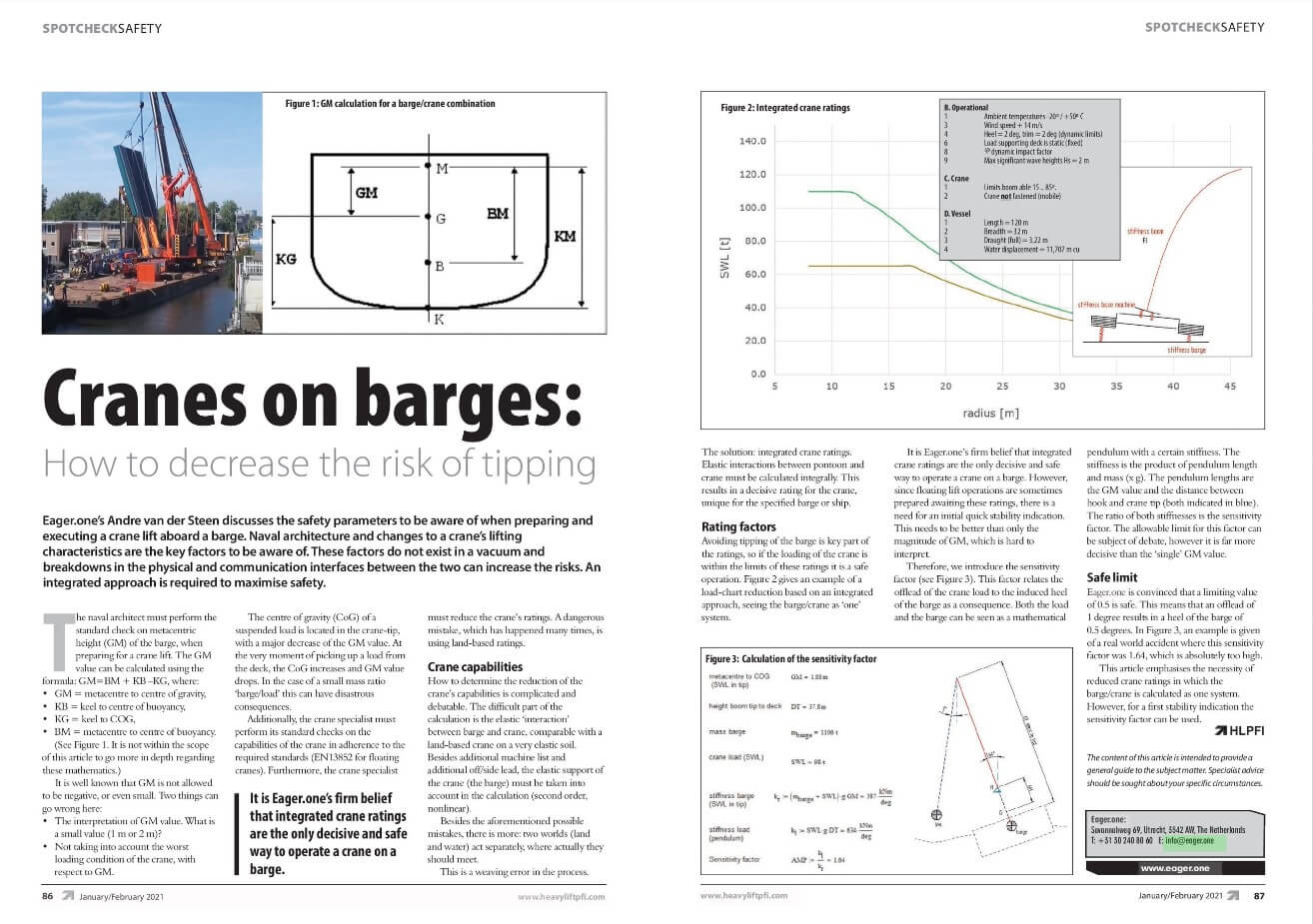
Cranes on barges: How to decrease the risk of tipping
Eager.one’s Andre van der Steen discusses the safety parameters to be aware of when preparing and executing a crane lift aboard a barge. Naval architecture and changes to a crane’s lifting characteristics are the key factors to be aware of. These factors do not exist in a vacuum and breakdowns in the physical and communication interfaces between the two can increase the risks. An integrated approach is required to maximize safety.
The naval architect must perform the standard check on metacentric height (GM) of the barge, when preparing for a crane lift. The GM value can be calculated using the formula: GM=BM + KB KG, where:
• GM = metacenter to center of gravity,
• KB = keel to center of buoyancy,
• KG = keel to COG,
• BM = metacenter to center of buoyancy.

(See Figure 1. It is not within the scope of this article to go more in depth regarding these mathematics. It is well known that GM is not allowed to be negative, or even small. Two things can go wrong here:
• The interpretation of GM value. What is a small value (1 m or 2 m)?
• Not taking into account the worst loading condition of the crane, with respect to GM.
The center of gravity (CoG) of a suspended load is located in the crane-tip, with a major decrease of the GM value. At the very moment of picking up a load from the deck, the CoG increases and GM value drops. In the case of a small mass ratio ‘barge/load’ this can have disastrous consequences. Additionally, the crane specialist must perform its standard checks on the capabilities of the crane in adherence to the required standards (EN13852 for floating cranes). Furthermore, the crane specialist must reduce the crane’s ratings. A dangerous mistake, which has happened many times, is using land-based ratings.
Crane capabilities
How to determine the reduction of the crane’s capabilities is complicated and debatable. The difficult part of the calculation is the elastic ‘interaction’ between barge and crane, comparable with a land-based crane on a very elastic soil. Besides additional machine list an additional off/side lead, the elastic support of the crane (the barge) must be taken into account in the calculation (second order, nonlinear). Besides the aforementioned possible mistakes, there is more: two worlds (land and water) act, where actually they should meet. This is a weaving error in the process.

The solution: integrated crane ratings. Elastic interactions between pontoon and crane must be calculated integrally. This results in a decisive rating for the crane, unique for the specified barge or ship.
Rating factors
Avoiding tipping of the barge is a key part of the ratings, so if the loading of the crane is within the limits of these ratings it is a safe operation. Figure 2 gives an example of a load-chart reduction based on an integrated approach, seeing the barge/crane as ‘one’ system.
It is Eager.one’s firm belief that integrated crane ratings are the only decisive and safe way to operate a crane on a barge. However, since floating lift operations are sometimes prepared awaiting these ratings, there is a need for an initial quick stability indication. This needs to be better than only the magnitude of GM, which is hard to interpret. Therefore, we introduce the sensitivity factor (see Figure 3). This factor relates the off lead of the crane load to the induced heel of the barge as a consequence. Both the load and the barge can be seen as a mathematical pendulum with a certain stiffness. The stiffness is the product of pendulum length and mass (x g). The pendulum lengths are the GM value and the distance between hook and crane tip (both indicated in blue). The ratio of both stiffness’s is the sensitivity factor. The allowable limit for this factor can be subject of debate, however it is far more decisive than the ‘single’ GM value.

Safe limit
Eager.one is convinced that a limiting value of 0.5 is safe. This means that an off lead of 1 degree results in a heel of the barge of 0.5 degrees. In Figure 3, an example is given of a real world accident where this sensitivity factor was 1.64, which is absolutely too high. This article emphasizes the necessity of reduced crane ratings in which the barge/crane is calculated as one system. However, for a first stability indication the sensitivity factor can be used.
This article was also published in the January/February edition of HLPFI magazine.

Online Masterclass “Cranes on barges”
During one of our recent exclusive online masterclasses we have presented the theory behind operating cranes on barges. From this 2-hour masterclass we have now created a summary video with all highlights. Click here if you are interested in this video.
Upcoming events
What we do
As an independent partner, we advise about, design and construct everything from concept study to project completed. Our in-house developed design software calculates everything concerning mobile cranes and bespoke heavy equipment, while our people offer the expertise and skills that secure your success.
GET YOUR PROJECT PREPARED
Consultancy / Design & Construction
Our 40 years of experience provides the basis of a successful start of your project: right from the FEED phase. Preparation is vital. Therefore our concept studies, method statements and mission equipment offer you all the support you need.
GET YOUR PROJECT EXECUTION SUPPORTED
Consultancy / Design & Construction
Our aim is to optimize your project team’s results. With our exclusive knowledge of lifting and transportation we eliminate and manage risks. This is how we reach our collective goal: Zero Accidents, Zero Incidents.
DESIGN OF LIFTING & TRANSPORT ASSETS
Engineering
We have built up a great deal of experience with the design of (mobile) cranes and bespoke heavy equipment such as piling machines and excavators. Our customer base includes the most prominent producers of cranes and heavy machinery worldwide.
We are eager to hear from you
Call +31 (0) 30 240 80 60 or use the contact form. We always respond within 24 hours.